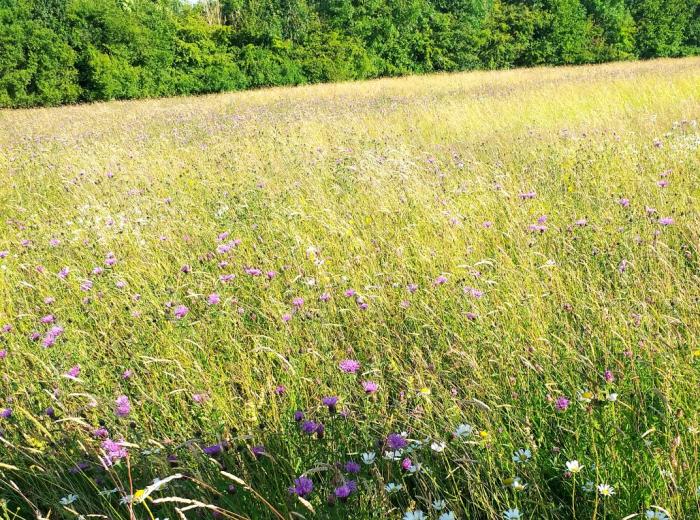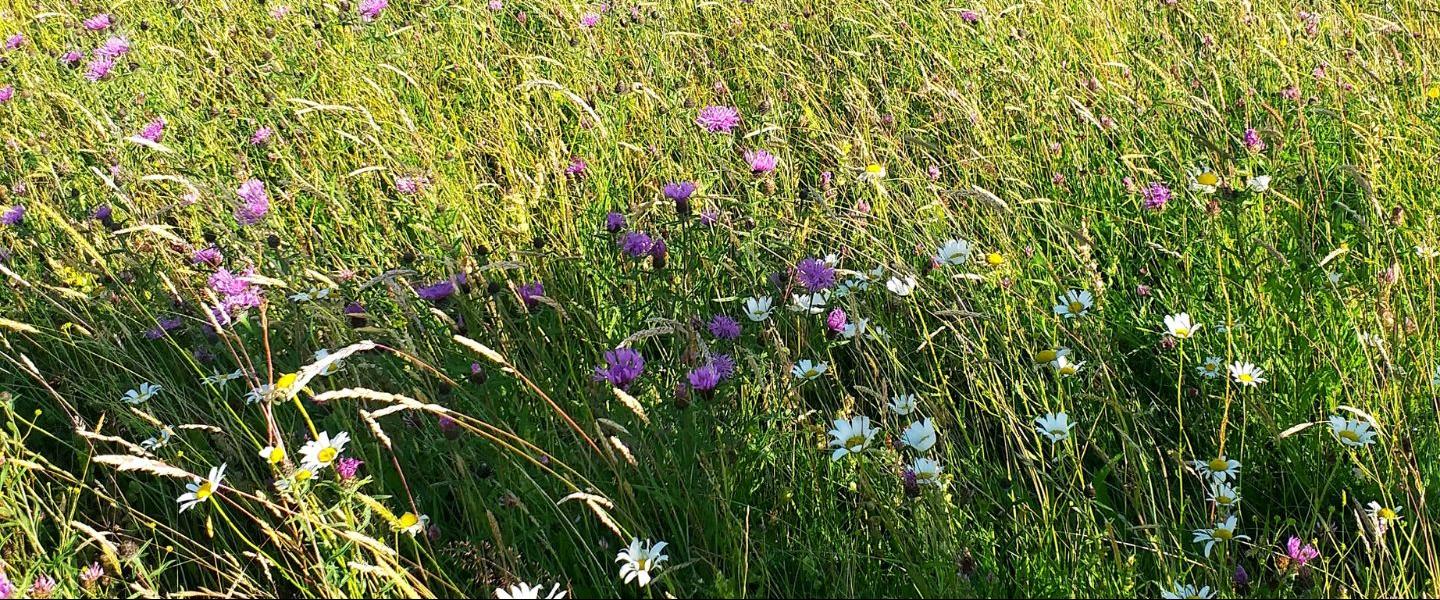As part of our commitment to increasing biodiversity, we’re pleased to be working with a local wildflower meadow specialist to create a wildflower meadow at Rowley Fields to contribute to the recovery of nature. This will encourage new habitats for wildlife, especially important as since World War II, the county has lost 97% of its traditional wildflower grasslands.
In 2023, we secured Biodiversity Net Gain funding (BNG), a government led scheme, which will enable us to create and maintain a wildflower meadow at Rowley Fields. Traditional wildflower meadows play a hugely important role in the biodiversity of an area. This is an investment in natural capital that will benefit both wildlife and everyone who enjoys Rowley Fields now and for generations to come.
Establishing a wildflower meadow is a long-term undertaking and one where things will look worse before they look better. In the early stages, and after the late summer hay cut, the grasses are cut back further and bare earth exposed. Yellow rattle seed is sown to deplete the ground of nutrients which in turn will encourage a variety of wildflower species to thrive.
This means that over the autumn and winter months, parts of Rowley Fields may look rather sad and neglected. This is all part of the plan, and in the spring, vegetation will return, and we will be able to assess the condition of the soil ahead of sowing the most appropriate wildflower mix.
Frequently Asked Questions
Who is paying for it?
Currently the Trust pay to maintain the fields. The meadow creation and ongoing maintenance will now be funded through Biodiversity Net Gain, a scheme of biodiversity offsetting. This saving for the Trust will mean that we have more money to award in grants each year.
How long will it take?
Our commitment to this project is for the next thirty years. The initial pilot phase of two acres will take approximately three years for the full benefits to be seen and we will be seeding the additional areas of the fields during this time so that at the end of three years, all the ground preparation and seeding will be completed.
What is the timeline for the project?
The work carried out will be weather dependent but the proposed timeline is as follows:
Year 1
- July/August 2024: Annual hay cut to take place as usual
- October – December: harrowing and seeding to take place of two acres.
- yellow rattle will deplete the soil of its nutrients and ensure as little competition as possible.
Year 2
- keep yellow rattle and introduce a sward (covered grass area)
- begin process for year 1 with additional four acres
Year 3
- introduce wildflower seeds (eg. including perennial flowers)
begin process with additional eight acres so that all fourteen acres have been planted
What will the area look like while the work is carried out?
The area will not look appealing at first as grass is being cut back to reveal bare soil. Please bear with us during this stage, the end result will be worth it!
Will I still be able to walk my dog there whilst the work is going on and after the meadow is established?
Yes. We have no plans to restrict people walking their dogs at Rowley Fields.
When will we see the benefits of the planting?
Optimal condition is achieved in year 15. However, we expect the wildflowers to create a beautiful display by year 3.
Will you be fencing off the areas being seeded?
We aren’t planning on using fencing but would appreciate people avoiding walking over the newly seeded areas. We will have some signage as a reminder of this and the existing trodden paths will remain open.
Is any ongoing maintenance required once the meadow is established?
Maintenance of a successful meadow is light touch and only required seasonally to keep the flowers in a decent condition. As part of the biodiversity net gain funding agreement the Ecology Team at Warwickshire County Council will be carrying out regular checks at agreed intervals.

Want to know more?
Meadows are part of a quintessentially English landscape, which throughout the spring and summer would have been full of colourful wildflowers and swaying grasses, full of grasshoppers, crickets and butterflies and the birds that depended on them. They provide a vibrant and beautiful spectacle that is now a rare sight in the modern landscape.
Since the 1930s processes including agricultural intensification have resulted in the decline of traditional meadows. Wildflowers prefer low fertility soils as vigorous grasses compete the wildflowers.
The return of traditional management comprising an annual haycut is the first step towards re-establishing a traditional meadow as annual haycutting will result in a net reduction of nutrients necessary for the native wildflowers and fine grasses to thrive.
Yellow rattle will be added this autumn/ early winter. Known as the "meadow maker" this plant is parasitic to grasses and will help to reduce their dominance giving the flowers a chance to compete. Expect to see the seedlings appearing in the sward from late Spring, with a sea of yellow flowering heads in the summer. Yellow rattle is an annual and completes its lifecycle in one year. Its component in a meadow will fluctuate from year to year and can dominate before it eventually finds a natural balance. Yellow rattle can reduce grass growth by up to 60%. The large seed pods ripen and dry and the seed rattles around inside which gives it its name.
Yellow rattle needs a prolonged period of chilling to enable germination the following spring. The seed will be sown in autumn/early winter. Seed bed preparation will be by heavy soil scarification (to 50-70% bare earth), after this the seed will be broadcast and then rolled in. The preparation of the seed bed can look extreme as a green sward is turned to bare earth but is essential for seed to soil contact and successful establishment.
What we are aiming to see long-term?
The aim of the project is to restore a wide range of native flowering plants, and grasses.to the meadows. Rowley Fields is what’s classified as a lowland neutral haymedow. The best lowland meadows can have up to 40 species of plant per square metre. In time species such as red and white clover, meadow buttercup, ribwort plantain oxeye daisies, common knapweed, birdsfoot trefoil, meadow vetchling and lady’s bedstraw will be introduced to the meadow but only after the yellow rattle has reduced the vigour of the grasses and the soil nutrient status has been reduced.
Meadows, like any other habitat have a natural succession. Yellow rattle, ribwort plantain and oxeye daisies can dominate in the early years of meadow reversion, latterly (sometimes after as long as 10 years, scarcer species such as Betony, Devils Bit Scabious and Common Spotted Orchids can begin to make an appearance. Other rarer species (eg Dyers Greenweed, Sawwort, Sneezewort) can also appear out of the seedbank as conditions become favourable and add an unpredictable element of magic to meadow reversion.

